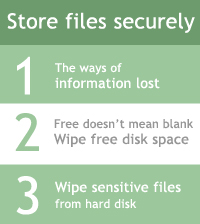Short
review on non-software methods of destruction of the information on hard
drives.
 Sometimes,
when the highest reliability is needed, itís using mechanical and other
methods of destruction of the information, when HDD is breaking as oneself. Sometimes,
when the highest reliability is needed, itís using mechanical and other
methods of destruction of the information, when HDD is breaking as oneself.
Get
evaluation version of QuickWiper from www.quickwiper.com
1.
Mechanical
action. Crushing
of the carrier passed through the shredder. HDD so collapses mechanically to
exclude an opportunity of perusal of the information from its working disks
in any way. There is a danger at this method, there can be fragments after
crushing, large enough to restore the information in laboratory conditions.
Opening
of the case in a working premise (outside of a pure room) leads to pollution
of plates and HDD conclusion out of operation. In modern HDD a dust, as a
sandpaper, erases a working layer up to a basis.
Frequently
methods of drilling of apertures used in practice and impacts by a hammer on
a drive actually at all do not destroy or destroy only a small part of the
information.
2.
Thermal.
Heating of the carrier to temperature of fusion in special furnaces. At this
way the guarantee of destruction of the information becomes at heating the
carrier up to temperature 800-1000C. In this case the information becomes
absolutely non-restorable on the whole complex of the reasons. Such way of
destruction of the information can be recommended for the carriers
containing the state secret.

A
fire in a working premise, where a personal computer is, or burning HDD does
not lead to destruct of the information.
3.
Pyrotechnic.
Destruction of the carrier by explosion.
4.
Metal-thermic.
Destruction of the disk substrate, directly magnetic covered, by heat
self-spreading high-temperature synthesis. Thus on a substrate the special thermal
layer is rendered.
5.
Chemical.
Destruction of a working layer or a basis of the carrier chemically excited
environments.
6.
Radiating.
Destruction of the carrier ionized radiation.
One
of them are ecologically unsafe, others can provide high reliability of
destruction of the information, but demand so specific and expensive
equipment, which is presumed by only single corporate users. In all these
methods there is no opportunity of reuse HDD. Thatís why we have to back
to software methods of data destruction and overview it.
Related
articles:
-
Points
on information storage and security. At
present IT-corporations invests millions of dollar in development of
information security techniques. But the only problem is researching how
to make public information accessible to all users, and confidential
data accessible only to whom
itís intended.
-
Short
review on non-software methods of destruction of the information on
hard drives. Sometimes,
when the highest reliability is needed, itís using mechanical and
other methods of destruction of the information, when HDD is breaking as
oneself.
-
Wipe
file and clear disk space. All
kinds of information is stored in computers as a files. Each file takes
some place on a hard disk. And the first (and main for our issue)
problem is you never know where itís placed, and how much disk space
it occupy.
-
Disk
space: free doesnít mean blank. Letís
repeat, when you delete sensitive files from a disk on your computer,
Windows does not erase the contents of these files from the disk - it
only deletes 'references' to these files from file system tables.
Contents of the deleted file continue to be stored on the disk space and
can be easily recovered using any unerasing utility.
|